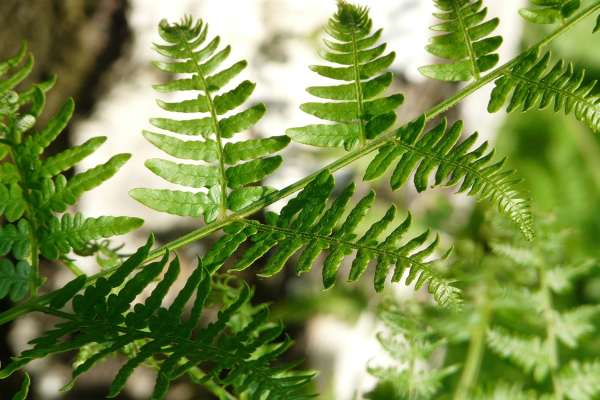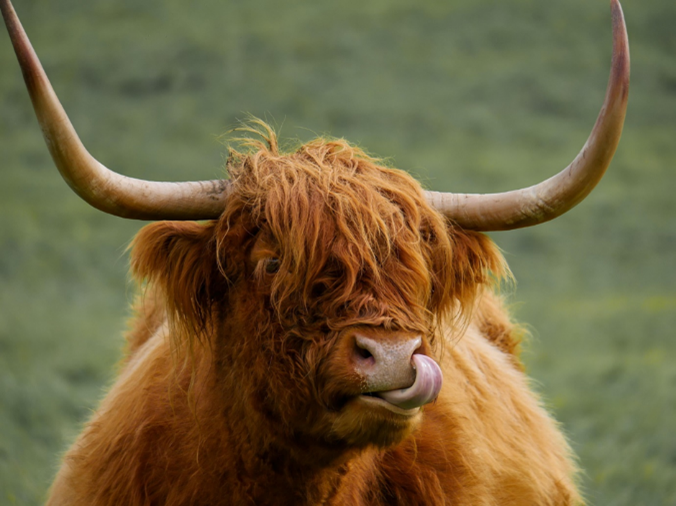Alternatives to Chemical Control of Bracken
27 October 2023For the last 10 years, Asulam (also known as Asulox) has been granted special approval on an annual basis for use in the control of bracken in Scotland. In June 2023, Scottish Government took the decision, after careful consideration, not to authorise emergency access to the chemical Asulam, which is commonly used in control of the invasive plant, bracken. The decision was taken because of the risks associated with the chemical to human, animal, and environmental health and on the advice of the Health and Safety Executive (HSE).

Image 1: Common bracken (Pteridium aquilinum) is an invasive species of fern that is common in temperate and subtropical environments.
So, what are the alternatives for bracken control and how effective are they?
Cutting
Cutting is probably the first thing most people will think of when they are considering alternatives to chemical control of bracken. Targeting the fronds of the plant as they start to unfurl will maximise success, preventing the plant from photosynthesising and weakening the root system. Those interested in cutting as a preferred method of management should undertake cutting around mid-June when bracken is around 50-75cm high, then again around six weeks later. If cutting is only possible once a year, then late summer should be prioritised for it. The effectiveness of cutting is not clear cut, with some groups suggesting that it is effective long-term, while others say it is only effective as part of a multifaceted management plan.
Bruising
Bracken bruising is another alternative. This involves crushing or trampling the plant, normally over late summer. Crucially, the plant should remain intact. By leaving the plant intact, it’s forced to respond to the damage inflicted and redirects resources that would have been used for reproduction to repair. Bracken bruising causes a kind of internal bleeding in the plant, weakening the root system (rhizomes), stressing the plant, and preventing spread. Bruising can be achieved by just about any machine or even animal. The use of quad bike-towed or horse-drawn rollers is becoming increasingly popular. Horses are particularly suitable where the terrain makes it dangerous to use vehicle drawn machinery. However, these activities often cannot feasibly be done at scale, at least not in a time-efficient manner. In the long-term, bracken bruising is effective but requires multiple years of action, presenting incremental improvement over time.
Grazing
Pigs are another option for bracken control. As omnivores, they have a terrific capacity for rooting and have a tremendous ability to turn green, vegetated areas black very quickly. This can facilitate the clearing of bracken, along with other invasive species. While highly effective, a couple of key considerations include the impacts of soil exposure and erosion, the land should be rested on a regular, recurring basis. It is also important to manage the pigs properly. Heat stress can be a problem in summer and care should be taken to provide a suitably varied diet to avoid bracken poisoning. The presence of ticks is another consideration and something that pig owners should plan for to maintain high standards of animal welfare. Finally, pigs are themselves difficult to contain and releasing them on a large area of hill could make it exceedingly difficult to track and retrieve them.

Image 2: Pigs are transformational, able to root up, expose and destroy the rhizomes of the bracken plant

Cattle perform many of the same functions in the uplands, trampling and bruising the plant while grazing, although they do not actively root up the plant. Cattle are also more easily returned to the farm and are unlikely to require the same level of infrastructure to contain them. New technologies, such as virtual fencing, provide scope to use cattle more extensively as landscape engineers.
Image 3: Native breeds of cattle are ideal conservation grazers, suited to the upland environment
Table 1: Summary of non-chemical control options
| Control method | Short-term impact | Long-term impact |
|---|---|---|
| Cutting | High: immediate impact stresses the plant and opens the canopy | Medium: impact is disputed and generally cutting is recommended in combination with other actions |
| Bruising | Low: the plant remains intact and can smother other plants present | High: continued bruising can result in the retreat of bracken over time |
| Grazing | Medium: trampling can have the same impact as bruising but requires infrastructure and animal welfare must be taken into consideration | Medium: can require high stocking rates to achieve extensive, landscape scale change over a long time period |
Chemical alternatives
For businesses in Scotland with land under specific uses such as ornamental plant production, forest nurseries and farm woodland, chemical control of bracken can be carried out using products containing the active ingredient Amidosulfuron. Trees, spruce, and pine species are tolerant to amidosulfuron. These herbicide products can be used under an Extension of Authorisation for Minor Use (EAMU). Users should be aware though that there may be additional conditions attached to using a product under an EAMU. Furthermore, any decision to use a product under an EAMU means that the user then assumes all commercial risk for use of the product.
For grassland and rough pastures, the use of glyphosate applied with a weed wiper is the only chemical control option available. The use of a trailed weed wipe provides a cost-effective method of control where other methods of control are not practicable. However, a trailed weed wipe will not be suitable for all locations and should not be used on steep slopes or rocky areas, for example. If you are using chemical control, timing is critical, the application of herbicides should be made once the fronds of the plant are fully expanded (typically July-August), just as they reach maturity but not beyond. This will ensure maximum translocation of the chemical into the root rhizomes for long term control.
Specialist advice should always be sought before undertaking chemical control of bracken and the product label should always be read before use. Anyone intending to use chemical control should also ensure that they have all the appropriate training and the legally required qualifications to do so. Where bracken control of any sort is proposed on a site of natural interest or where conservation is important, options should be discussed with NatureScot in the first instance.
Managing risks
Working in the farmed environment, whether in the uplands or elsewhere, there are always risks that should be identified, and where possible eliminated or mitigated. In the context of bracken control, a number of different forms of personal protective equipment (PPE) will be appropriate, these will most likely include protective footwear, hi-vis clothing and hardhats, as well as additional PPE in line with the tool or machinery manufacturer’s instructions. Undertaking manual and mechanical control of bracken could mean participating in several activities likely to constitute a hazard, these could include, but are not limited to, striking injuries, Lyme’s disease from ticks, slips, trips and falls, as well as hazards associated with weather conditions – including hot weather.
Wherever possible, farmers, contractors and land managers should not undertake control alone. Use of heavy machinery and equipment brings risks that can be mitigated with assistance, this also supports efficient working. Individuals working on control should also make their intended location known prior to departing for the control site. Where possible they should have a method of contacting others, should the need arise. GPS trackers and similar equipment are now available to allow individuals to be located across great distances. These are particularly useful over large areas of hill ground where mobile phone signals may not be reliable.
Depending on how the bracken is being controlled there is also potential for vehicle collisions, as well as tipping and falling from them, which can be particularly dangerous and result in serious injury or fatalities. A health and safety assessment should be carried out in advance of any control activities, allowing reasonable time for review and where appropriate additional corrective action to further reduce the risks identified. While all-terrain vehicles are designed for challenging environments, no amount of bracken is worth taking risks that might place you or your team in a dangerous position.
Related FAS Material
Related External Material
Sign up to the FAS newsletter
Receive updates on news, events and publications from Scotland’s Farm Advisory Service
